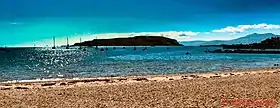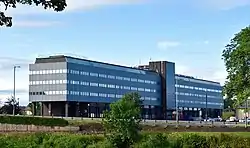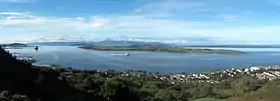North Ayrshire
North Ayrshire (Scots: North Ayrshire; Scottish Gaelic: Siorrachd Àir a Tuath, pronounced [ˈʃirˠəxk aːɾʲ ə t̪ʰuə]) is one of 32 council areas in Scotland. It has a population of roughly 135,280 people.[1] It is located in the southwest of Scotland, and borders the areas of Inverclyde to the north, Renfrewshire to the northeast and East Ayrshire and South Ayrshire to the east and south respectively. North Ayrshire Council is a hung Council. North Ayrshire also forms part of the east coast of the Firth of Clyde.[2]
North Ayrshire
Scottish Gaelic: Sìorrachd Àir a Tuath | |
|---|---|
 Coat of arms  Council logo | |
 | |
| Coordinates: 55°40′N 4°47′W | |
| Sovereign state | United Kingdom |
| Country | Scotland |
| Lieutenancy area | Ayrshire and Arran |
| Admin HQ | Irvine |
| Government | |
| • Body | North Ayrshire Council |
| • Control | Labour minority (council NOC) |
| • MPs | |
| • MSPs | |
| Area | |
| • Total | 341.9 sq mi (885.4 km2) |
| Area rank | Ranked 17th |
| Population (mid-2019 est.) | |
| • Total | 135,280 |
| • Rank | Ranked 15th |
| • Density | 400/sq mi (150/km2) |
| ONS code | S12000021 |
| ISO 3166 code | GB-NAY |
| Website | www |
History and formation
The area was created in 1996 as a successor to the district of Cunninghame. The council headquarters are located in Irvine, which is the largest town. The area also contains the towns of Ardrossan, Beith, Dalry, Kilbirnie, Kilwinning, Largs, Saltcoats, Skelmorlie, Stevenston, West Kilbride, as well as the Isle of Arran and the Cumbrae Isles. The Isle of Arran covers nearly half of the council area's territory, but is home to less than 4% of the population. North Ayrshire is known for its rural countryside, coastlines, beaches and landmarks. It is a mostly affluent area with the population being among the least deprived in Scotland. However a few parts of the area have some deprivation, this is mostly towards the south of the area in Saltcoats and Stevenston where there is some deprived areas.
The towns in the north of the area, Skelmorlie, Largs, Fairlie and West Kilbride are affluent commuting towns and with them being on the coast, are very popular with tourists during the summer months. Towns in the south include the three towns Ardrossan, Saltcoats and Stevenston as well as the affluent town of Kilwinning. Towards the south of the area is Irvine which is also the main settlement and largest town in the area. The inland towns of Dalry, Kilbirnie and Beith were steel towns with large steel mills however these are long gone. Tourism is the main industry on Arran and Cumbrae; however, the number of holiday homes on the latter has begun to squeeze locals out of the housing market. Regeneration is currently taking place at Ardrossan Harbour and Irvine town centre, and there has been a rapid increase in the construction of new housing in recent years.
Kelburn Castle, Fairlie, is the home of the 10th Earl of Glasgow, Patrick Robin Archibald Boyle. The grounds have belonged to the Boyle family since the 1100s. In 2007, the castle was transformed by the Graffiti Project.
Isle of Arran
From the 17th to the late 20th century, Arran was part of the County of Bute.[3] After the 1975 reorganisation of local government Arran became part of the district of Cunninghame in Strathclyde Region.[4] This two-tier system of local government lasted until 1996 when the Local Government etc. (Scotland) Act 1994 came into effect, abolishing the regions and districts and replacing them with 32 council areas. Arran is now in the North Ayrshire council area, along with some of the other constituent islands of the County of Bute.
For some statistical purposes Arran is within the registration county of Bute,[5] and for ceremonial purposes it forms part of the lieutenancy area of Ayrshire and Arran.
In the House of Commons, since 2005 it has been part of the Ayrshire North and Arran constituency, represented since 2015 by Patricia Gibson of the SNP. It is marginal between the SNP and the Scottish Conservatives. It had been part of Cunninghame North from 1983 to 2005, and of Ayrshire North and Bute from 1918 to 1983.
In the Scottish Parliament, Arran is part of the constituency of Cunninghame North, currently represented by Kenneth Gibson of the Scottish National Party (SNP). The Labour Party held the seat until 2007, when the SNP gained it by 48 votes, making it the most marginal seat in Holyrood until 2011, when the SNP increased its majority to 6,117 over Labour.[6]
Economy

North Ayrshire has a slightly higher level of unemployment within Scotland.[7] North Ayrshire launched an Economic Recovery and Renewal Strategy in September 2020 focusing on economic recovery and a renewal approach which aims to sets out a comprehensive plan for an inclusive and green economic recovery for North Ayrshire. A £8.8 million Investment Fund will be used as a key element of a Green New Deal by:
- Maximising renewable energy generation using the Council’s land and assets
- The creation of a new Green Jobs Fund to ensure a just transition for North Ayrshire;
- Investing in commercial estate including improving sustainability;
- Tackling vacant and derelict land and buildings in town centres;
- Supporting community economic development including through community regeneration and ownership
- A tree-planting programme to support carbon absorption
In May 2020, North Ayrshire Council became the first council in Scotland to become a Community Wealth Building (CWB) Council, setting out a new economic model focused on wellbeing and inclusion. North Ayrshire Council seeks to use Community Wealth Building objectives to support the recovery and renewal of North Ayrshire by creating an economy that works for people, place and planet.
The North Ayrshire approach will see the creation of a new £660,000 Community Wealth Building Business Fund to provide assistance to local business and facilitating the development of co-operatives, employee ownership and social enterprises, supporting local supply chains, fair employment, digital adoption and the transition to a green economy. North Ayrshire is to benefit from the Ayrshire Growth Deal, an economic plan created by both the Scottish Government and UK Government. The £250 million Ayrshire Growth Deal is also central to the plans to support economic recovery through a bold and ambitious investment programme to create and secure jobs within the area of North Ayrshire.[8]
Government
North Ayrshire | |
|---|---|
| Structure | |
| Seats | 26 councillors |
 | |
11 / 33 | |
11 / 33 | |
7 / 33 | |
4 / 33 | |
| Elections | |
| Single transferable vote | |
Last election | 4 May 2017 |
| Meeting place | |
 Cunningham House, Irvine | |
| Website | |
| www | |
The SNP formed a minority administration in the North Ayrshire council area in May 2012, however, they were replaced by the Labour Party following a by-election in Irvine West in 2016. At the House of Commons, North Ayrshire is covered by the Central Ayrshire and North Ayrshire and Arran Parliamentary constituencies, both of which are represented by MPs belonging to the Scottish National Party. In the Scottish Parliament, the council area is divided into Cunninghame North and Cunninghame South, both represented by MSPs from the Scottish National Party.
Towns and villages
The main administration centre and largest settlement in North Ayrshire is Irvine, a new town on the coast of the Firth of Clyde, with a population of 33,698.
The second biggest settlement is Kilwinning which has a population of over 18,000. Other major population centres include Largs, and the 'Three Towns' - Ardrossan, Saltcoats and Stevenston.
On the Isle of Arran, the largest village is Lamlash and there are numerous smaller villages. On Great Cumbrae, the only town on the island is Millport.
Towns (mainland)
Villages (mainland)


Suburbs (mainland)
- Barkip
- Broomlands
- Bourtreehill
- Burnhouse
- Castlepark
- Crosbie
- Chapeltoun
- Cunninghamhead
- Dalgarven
- Drakemyre
- Eglinton
- Fergushill
- Fullarton
- Giffordland
- Greenhills
- Hessilhead hamlet
- Highfield
- Hunterston
- Kelburn
- Lawthorn
- Lylestone
- Meigle
- Meikle Auchengree
- Montgreenan
- Nettlehirst
- Perceton
- Portencross
- Routenburn
- Seamill
- Sevenacres
- Shewalton
- Torranyard
Towns (Isle of Arran)
Villages (Isle of Arran)

Settlements (Great Cumbrae)
Places of interest
References
- "Population Estimates for UK, England and Wales, Scotland and Northern Ireland, Mid-2019". Office for National Statistics. 6 May 2020. Retrieved 6 May 2020.
- "East coast, Firth of Clyde" (PDF). Retrieved 16 December 2016.
- Downie (1933), p. 1, confirms this status at the publication date.
- "District: Cunninghame" Archived 6 September 2012 at the Wayback Machine. ScotlandsPlaces. Retrieved 2 June 2011.
- "Land Register Counties: Operational Dates and Alphabetical List of Places in Scotland" (PDF). Registers of Scotland. 2015. Retrieved 2018-05-14.
- "2007 Election Results Analysis: Table 18" (pdf) scottish.parliament.uk. Retrieved 17 July 2009.
- https://lgiu.org/north-ayrshires-new-green-deal/
- https://lgiu.org/north-ayrshires-new-green-deal/